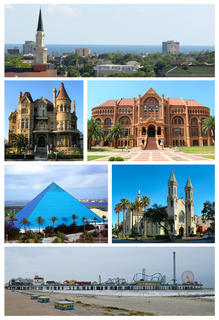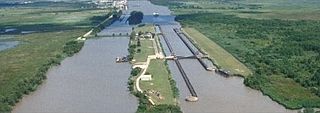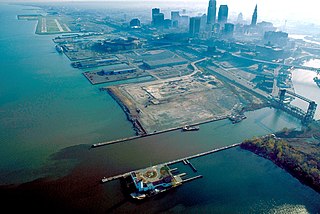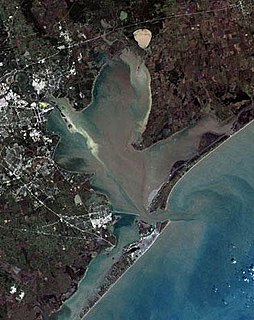| Port of Texas City | |
|---|---|
| Location | |
| Country | United States |
| Location | Texas City, Texas |
| Coordinates | 29°22′15″N94°53′47″W / 29.370872°N 94.896394°W Coordinates: 29°22′15″N94°53′47″W / 29.370872°N 94.896394°W |
| UN/LOCODE | USTXT [1] |
| Details | |
| Opened | 1893 [2] |
| Operated by | Port of Texas City / Texas City Terminal Railway Company |
| Owned by | Union Pacific Railroad, Burlington Northern Santa Fe Corporation [3] |
| Type of harbor | Natural/artificial |
| Statistics | |
| Annual cargo tonnage | 52,606,030 short tons (47,723,390 t) [4] |
| Value of cargo | US$10.8 billion [5] |
| Website http://www.tctrr.com/ | |
The Port of Texas City is a major deepwater port in Texas City, Texas at Galveston Bay, United States. [6] Its location on the bay, which is used by the Port of Houston and the Port of Galveston, puts Texas City in the heart of one of the world's most important shipping hubs. As of 2008 [update] the Port of Texas City was the 14th leading port in the United States by total tons of trade and as of 2007 it was the 87th leading port in the world, according to the American Association of Port Authorities.
In 2008, the total trade at the port was 52,606,030 short tons (47,723,390 t) making Texas City the third leading port in Texas and the 14th leading port in the United States. As of 2007 [update] it was also the 87th leading port in the world. [4] [7] Of that 33,926,630 short tons (30,777,720 t) was foreign imports (7th in the U.S.), 4,783,805 short tons (4,339,795 t) was foreign exports (27th in the U.S.), and 13,895,595 short tons (12,605,872 t) was domestic trade (20th in the U.S.). [4] In 2005, the total value of foreign trade shipped through the port was US$10.8 billion (22nd in the U.S.). Of that the value of foreign imports was US$9.22 billion (22nd in the U.S.) and the value of foreign exports was US$1.6 billion (25th in the U.S.). [5]
In 1947, an explosion aboard the French-flagged S.S. Grandcamp, docked at Texas City, triggered fires and explosions throughout the port and the industrial complex. The resulting destruction is considered by many to be the worst industrial tragedy in the history of the United States. The fires caused more than five hundred deaths, more than four thousand injuries, and more than US$50 million in damage (US$573 million in today's dollars). In spite of the destruction the city was able to rebuild quickly and the port soon re-opened. [8]

Galveston is a coastal resort city and port off the Southeast Texas coast on Galveston Island and Pelican Island in the U.S. state of Texas. The community of 209.3 square miles (542 km2), with a population of 47,743 in 2010, is the county seat of surrounding Galveston County and second-largest municipality in the county. It is also within the Houston–The Woodlands–Sugar Land metropolitan area at its southern end on the northwestern coast of the Gulf of Mexico.

Texas City is a city in Galveston County in the U.S. state of Texas. Located on the southwest shoreline of Galveston Bay, Texas City is a busy deepwater port on Texas' Gulf Coast, as well as a petroleum-refining and petrochemical-manufacturing center. The population was 50,094 in 2019, making it the third-largest city in Galveston County, behind League City and Galveston. It is a part of the Houston metropolitan area. The city is notable as the site of a major explosion in 1947 that demolished the port and much of the city.

Greater Houston, designated by the United States Office of Management and Budget as Houston–The Woodlands–Sugar Land, is the fifth-most populous metropolitan statistical area in the United States, encompassing nine counties along the Gulf Coast in Southeast Texas. With a population of 6,997,384 people at the 2018 census estimates and over 7 million in 2020, Greater Houston is the second-most populous in Texas after the Dallas–Fort Worth metroplex. The approximately 10,000-square-mile (26,000 km2) region centers on Harris County, the third-most populous county in the U.S., which contains the city of Houston—the largest economic and cultural center of the South—with a population of more than 2.3 million. Greater Houston is part of the Texas Triangle megaregion along with the Dallas–Fort Worth metroplex, Greater Austin, and Greater San Antonio. Greater Houston also serves as a major anchor and economic hub for the Gulf Coast. Its Port of Houston is the second largest port in the United States, sixteenth largest in the world, and leads the U.S. in international trade.

The Gulf Intracoastal Waterway is the portion of the Intracoastal Waterway located along the Gulf Coast of the United States. It is a navigable inland waterway running approximately 1,050 mi (1,690 km) from Carrabelle, Florida, to Brownsville, Texas.
The Port of Houston is one of the world's largest ports and serves the metropolitan area of Houston, Texas. The port is a 50-mile-long complex of diversified public and private facilities located a few hours' sailing time from the Gulf of Mexico. Located in the fourth-largest city in the United States, it is the busiest port in the U.S. in terms of foreign tonnage, second-busiest in the U.S. in terms of overall tonnage, and sixteenth-busiest in the world. Though originally the port's terminals were primarily within the Houston city limits, the port has expanded to such a degree that today it has facilities in multiple communities in the surrounding area. In particular the port's busiest terminal, the Barbours Cut Terminal, is located in Morgan's Point.

The Galveston Railroad is a Class III terminal switching railroad headquartered in Galveston, Texas. It primarily serves the transportation of cargo to and from the Port of Galveston.

The Houston Ship Channel, in Houston, Texas, is part of the Port of Houston, one of the busiest seaports in the world. The channel is the conduit for ocean-going vessels between Houston-area terminals and the Gulf of Mexico, and it serves an increasing volume of inland barge traffic.

Port Tampa Bay, known as the Port of Tampa until January 2014, is the largest port in the state of Florida and is overseen by the Tampa Port Authority, a Hillsborough County agency. The port is located in Tampa, Florida near downtown Tampa's Channel District. The port directly accesses Tampa Bay on the western coast of the Florida Suncoast, and is approximately 25 sea miles from the Gulf of Mexico. The port district includes parts of Tampa Bay, Hillsborough Bay, McKay Bay, Old Tampa Bay and the Hillsborough River. The port serves container ships, tank ships, and cruise lines.

The Port of Beaumont is a deep-water port located in Beaumont, Texas near the mouth of the Neches River.

The Port of Mobile is a deep-water port in Mobile, Alabama, United States. It is the only deep-water port in Alabama. It was ranked by the United States Army Corps of Engineers as the 9th largest port by tonnage in the nation during 2014, with a trade volume of 64.3 million tons. This ranking had increased from 12th largest during 2010, with a trade volume of 55,713,273 tons and increase of 19.1%.

The Port of New York and New Jersey is the port district of the New York-Newark metropolitan area, encompassing the region within approximately a 25-mile (40 km) radius of the Statue of Liberty National Monument. It includes the system of navigable waterways in the New York–New Jersey Harbor Estuary, which runs along 650 miles (1,050 km) of shoreline in the vicinity of New York City and northeastern New Jersey, as well as the region's airports and supporting rail and roadway distribution networks. Considered one of the largest natural harbors in the world, the port has become the second busiest port by tonnage in the United States as of 2019, and the busiest on the East Coast.

The economy of the State of Texas is the second largest by GDP in the United States after that of California. It has a gross state product of $1.887 trillion as of 2019. As of 2015, Texas is home to six of the top 50 companies on the Fortune 500 list and 51 overall. In 2017, Texas grossed more than $264.5 billion a year in exports—more than the exports of California and New York combined.
This is a documentation of the routes, highways, parking requirements, or anything related to transportation in Houston.
The Texas Department of Transportation (TxDOT) is a governmental agency and its purpose is to "provide safe, effective, and efficient movement of people and goods" throughout the state. Though the public face of the agency is generally associated with maintenance of the state's immense highway system, the agency is also responsible for aviation in the state and overseeing public transportation systems.

The Port of Galveston is the port of the city of Galveston, Texas. It was established by a proclamation issued by the Congress of Mexico on October 17, 1825, while the land known today as Texas was still part of Mexico. The Port of Galveston is the oldest port in the Gulf of Mexico west of New Orleans.

The Port of Cleveland is a bulk freight and container shipping port at the mouth of the Cuyahoga River on Lake Erie in Cleveland, Ohio, United States. It is the third-largest port in the Great Lakes and the fourth-largest Great Lakes port by annual tonnage.

The History of Galveston, Texas, begins with the archaeological record of Native Americans who used the island. The first European settlements on the island were constructed around 1816. The Port of Galveston was established in 1825 by the Congress of Mexico following its successful revolution from Spain. The city served as the main port for the Texas Navy during the Texas Revolution. Galveston was founded in 1836 by Matthew Sabo and served as the capital of the Republic of Texas. The Battle of Galveston was fought in Galveston Bay during the American Civil War when Confederate forces under Major General John B. Magruder attacked and expelled occupying Union troops from the city.

For a period of over 7000 years, humans have inhabited the Galveston Bay Area in what is now the United States. Through their history the communities in the region have been influenced by the once competing sister cities of Houston and Galveston, but still have their own distinct history. Though never truly a single, unified community, the histories of the Bay Area communities have had many common threads.

The Barbours Cut Container Terminal, or simply the Barbours Cut Terminal, is a major deep water port in the Greater Houston area in the U.S. state of Texas. It is part of one of the world's busiest ports by cargo tonnage.
The Bayport Container Terminal, or simply the Bayport Terminal, is a major deep water port in the Greater Houston area in Texas. This relatively new terminal, part of the Port of Houston, is designed to handle standardized cargo containers and offload the nearby Barbours Cut Terminal, which has no further room for expansion. The Bayport Terminal is situated along the Bayport Ship Channel off Galveston Bay, between La Porte, Texas and Seabrook, Texas. This channel itself feeds into the larger Houston Ship Channel, which runs from Houston, through Galveston Bay, to the Gulf of Mexico.